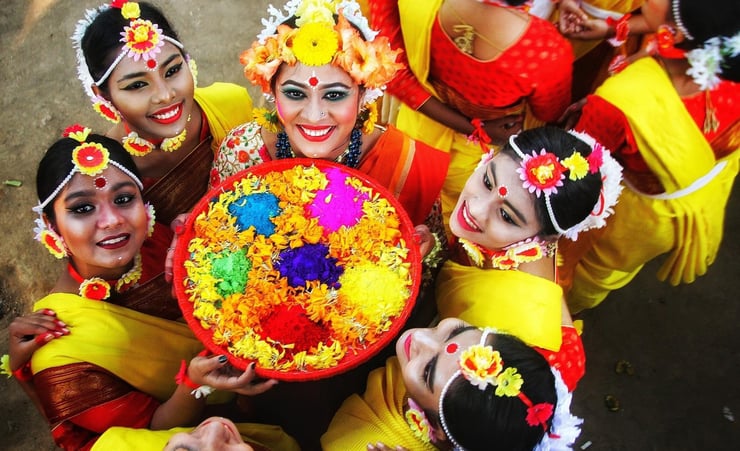What is Poila Boishakh ?

Happy New Year!
Yes, we realise it's already April of 2022, but that is precisely what you'll be saying if you were a Bengali. To be more precise, you'd be saying "subho noboborsho" (which roughly means happy new year in Bengali) because you'd be celebrating the beginning of a Bengali new year or "Poila Boishakh."
In India, Poila Boishakh, which marks the beginning of the starting month of Baishakh (or Boishakh, depending on how you pronounce it) on the Bengali calendar, is celebrated on either the 14th or the 15th of April. This year, it is falling on the 15th. It isn't just Bengalis, though - in India, Sikhs and Hindus also celebrate the beginning of the new year through the festival of Vaisakhi or Baisakhi.
But we're not in India; we're in NZ. So how does the Bengali community celebrate Poila Boishakh here?
Indian Weekender spoke to Debes Bhattacharyya, a prominent member of the Bengali community here in New Zealand, to find out more. He was the President of the Probasee Bengalee Association of New Zealand for many years and also represented the Bengali community in the Indian Central Association (ICM) in NZ. He also works as a priest or pujari for the various community pujas (e.g. Durga Puja, Lakshmi Puja, Kali Puja) celebrated by the Bengali community.
What is your connection to the Bengali community and its origins?
The community was formed through the celebration of Durga Puja. We started in 1992 and held the Durga Puja in our own house for three years. It was a relatively small group of people. Gradually we expanded, and the numbers were increasing, so we finally shifted to the community and school halls.
At the end of the 1990s, we formed an Association called the Probasee Bengalee Association. We continued to hold the Durga Puja for a while under a general umbrella. But then we shifted under the administration of Probasee because other pujas started as well. Since then, other groups have been formed. There's a younger group called Bhavna, which takes the primary initiative for Kali Puja. Often we hold joint programs. Bangladeshi people have their groups as well. Also, there is another group called Nandan. So we maintain good relations with all of them.
What is the history behind Poila Boishakh?
There is a bit of controversy regarding the origin of Poila Boishakh. Some people say Emperor Akbar started it to ease tax collection. But some people also have argued now that they have found that even during the Vikramaditya Shashanka era, they found what's called Bongabda, meaning Bengali year. So we can't say definitely when it started.
In Bengal, they invite people and distribute sweetmeats irrespective of religion. They've got big processions in Dhaka, and they hold that as a new year festival. We have a prevalent theme of the singing of 'Rabindra Sangeet' (songs by Rabindranath Tagore), such as 'eso he Boishak, eso eso,' meaning 'please come to Boishakh.'
Here in NZ, we often cannot hold it precisely on that day because programs are organised depending on the weekends. Sometimes, if there is any problem, we have tried to combine that with the 8th of May, Rabindranath Tagore's birthday or Rabindra Jayanti. Throughout the month, people buy new clothes. We have dances, music, and get-togethers.
You mentioned that you are a priest and that you sometimes hold the pujas (prayers) for the Bengali community. So you still do that?
No, I don't do it anymore. I celebrate at home by cooking some sweetmeats and things like that and invite a few friends. But the community festival is held in a communal form. That means you invite all the other people irrespective of religion. We usually hold it in an auditorium. Of course, it has been disturbed in the last two years due to Covid.
So last year what we did, for the Rabindra Jayanti and nobho borsho, we had a zoom festival. It went very well. It had singers from NZ, Australia and India performing, and it continued for more than three hours.
So what about this year? Are you planning to do a zoom meeting again?
This year, the committee has been very cautious. Last even Durga Puja, I did it at home and telecast the Pushpanjali (offering flowers with prayer) on zoom so that people could give anjali in their own homes. So this year, we are holding back, and if the situation improves, we are thinking of doing something in May.
As you mentioned, usually during Poila Boishakh, people buy many new clothes. Is there any particular colour for the clothes that they buy?
No. But at the festival, usually, the Basanti colour, the yellowish saffron colour, is prevalent. So usually, the dancers and the young ladies will wear a white (or Basanti saree) with a Basanti/red border. Even the male participants will try to wear that particular colour set. So we try to bring some kind of uniformity there.
What is the significance of the saffron colour?
The year starts in spring, which is basanto. In Bengali, we call spring basanto, and the colour of basanto is Basanti, signifying the bright colours of spring. Basanti Puja (a form of Durga) is also held during this period.
And there you have it. To all our Bengali bhaiyo aur beheno, we hope you have a great Poila Boishakh!
Shubo noboborsho to everyone!





